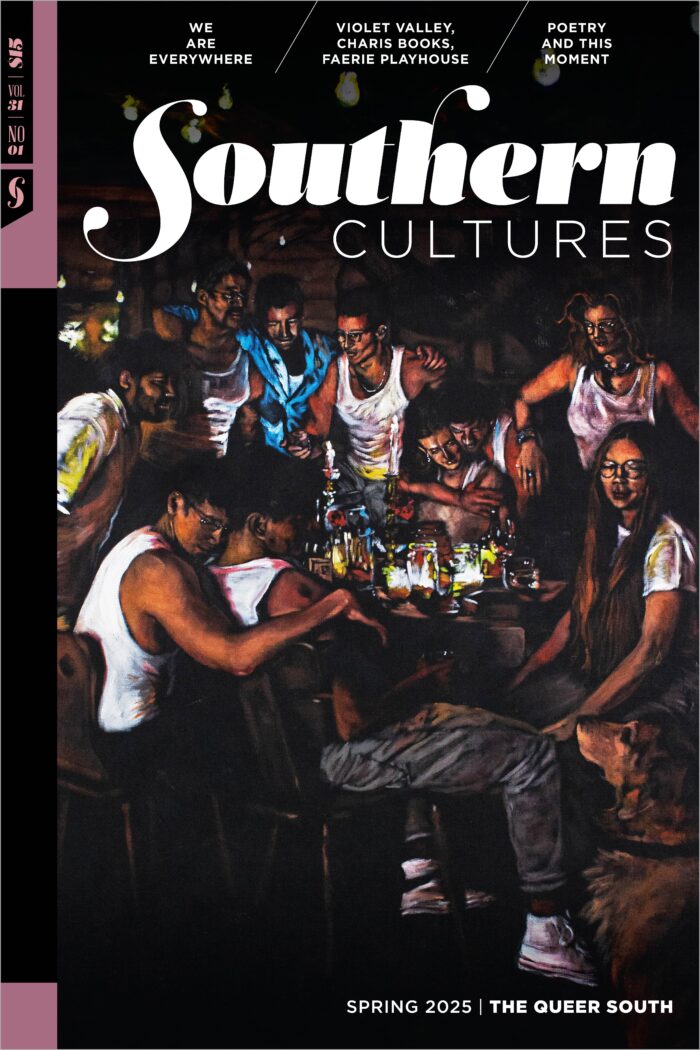This article first appeared in the Summer 2014 Issue.
For most of my youth, Elizabeth Glynn Griffitts (my paternal grandmother) was a hushed subject. I distinctly remember a gathering at my Aunt Janet’s home when I was about thirteen. It was the first time I had ever seen a photograph of Elizabeth. She was regal, dressed in turn-of-the-century finery: long lace dress and hat. She was driving a one-horse decorated carriage, whip and reins in hand. I looked at her confident face, with her proud expression, and realized a connection that speaks to me to this very day, almost a half century later.
For much of my adult life I have felt a desire—no, a compulsion—to tell Elizabeth’s story. I simply feel I owe it to her. I think about all of the women like Elizabeth who may have had unusual personalities or unresolved marital issues. Often confined in institutions against their will, taken from their children . . . I am so sorry for my grandmother. I wish I could go back in time and rescue her.1 —Shelley Griffitts
Her name was never to be spoken. Even upon the lips and within the hearts of her own children, remembrance was forbidden. Silence nearly erased her from history. For almost a century, Elizabeth Glynn Griffitts remained little more than a skeleton in the closet of a proud and prominent southern family, a woman, much like the “mad women” of novels and history, shut away and supposedly forgotten forever—until her granddaughters, armed with little more than a captivating photograph and whispered rumors, dedicated decades to the recovery of Elizabeth’s existence.
A woman, dragged from her home on the arms of her husband and two police officers while her five children watched on, glimpsing their mother for the final time; a woman, forcibly institutionalized at Alabama’s infamous Bryce Hospital in 1924 and abandoned there for the remaining thirty years of her life; a woman, once bright and beautiful, left to deteriorate until she possessed only one eye, five teeth, and mere rags to wear, a lonely broken shell of her former elegance; a woman, perhaps eccentric, perhaps outspoken, and likely unhappy, but nonetheless lucid and capable, sent away to disappear at the injunction of her nationally renowned physician husband: this is her story, pieced together from medical records, case histories, letters on hospital file, and long-repressed family remembrances. Unwilling or unable to perform the brand of femininity compulsory for a woman of her class and race, a northern transplant living in a region holding tenuously to social rules changing with frightening rapidity, Elizabeth’s life in Alabama offered her more restrictions than opportunities. Her story, then, proves not simply individual, nor merely personal. Instead, hers is the story of an inconvenient woman conveniently named insane in the 1920s Deep South, sentenced to complete her life within the walls of an insane asylum that reflected in microcosm the fears and desires of the larger culture it occupied.
She was not alone in this fate.
When it first opened in Tuscaloosa in 1861, Bryce Hospital—then known as Alabama State Hospital for the Insane—modeled the “moral treatment” philosophy characteristic of the era. This philosophy, championed most famously by Dorothea Dix, eschewed shackles and straightjackets in favor of therapeutically wholesome domestic environments. Built on the famous “moral architecture” plan devised by Thomas Kirkbride, the hospital, a sprawling Victorian-style estate with rolling hills outside and home-like settings within, originated as a paragon of psychiatric reform. However, by the early 1900s, moral treatment had been discredited and such vast buildings were nearly impossible to heat, cool, clean, or adequately staff. These deficiencies, paired with Bryce Hospital’s location within an impoverished region unable to match northern standards of psychiatric care, caused the conditions and reputation of the institution to fall into sharp decline. Spurred on by rumors of unfit conditions, the press, as well as the American Psychiatric Association (APA), pursued multiple investigations at Bryce over the course of the twentieth century. Results reveal steadily increasing overpopulation, insufficient and non-nutritive food, an underpaid and underperforming staff working at patient ratios grossly exceeding APA standards, as well as patient neglect and abuse.
In 1907, seventeen years before Elizabeth’s commitment, one reporter for the “Legislative Investigation of the Alabama Insane Hospitals” classified Bryce as a “veritable dumping ground” for unwanted people—a trend that would only intensify over the decades that followed. In 1957, just three years after Elizabeth’s death at Bryce, an APA investigation reported that the hospital, originally built for roughly four hundred patients, housed nearly five thousand, with a doctor-to-patient ratio of 1:440 compared to an APA standard ratio of 1:95, and a meager cost per patient per day of $2.40. Sixteen years after her death, in 1970, the hospital housed over 5,200 patients living in what one reporter would call “concentration camp conditions.” That same year, the landmark patient’s rights lawsuit against Bryce Hospital, Wyatt v. Stickney, resulted in the creation of federal policy governing minimum standards for patient care. Suffice to say, a long and troubled history animates the grounds of that now-abandoned and vandalized Victorian building, built with the noblest of intentions but unable to sustain its plans.2 Thirty years of this long, troubled history belonged, in part, to Elizabeth Griffitts, who unwillingly experienced it from within.
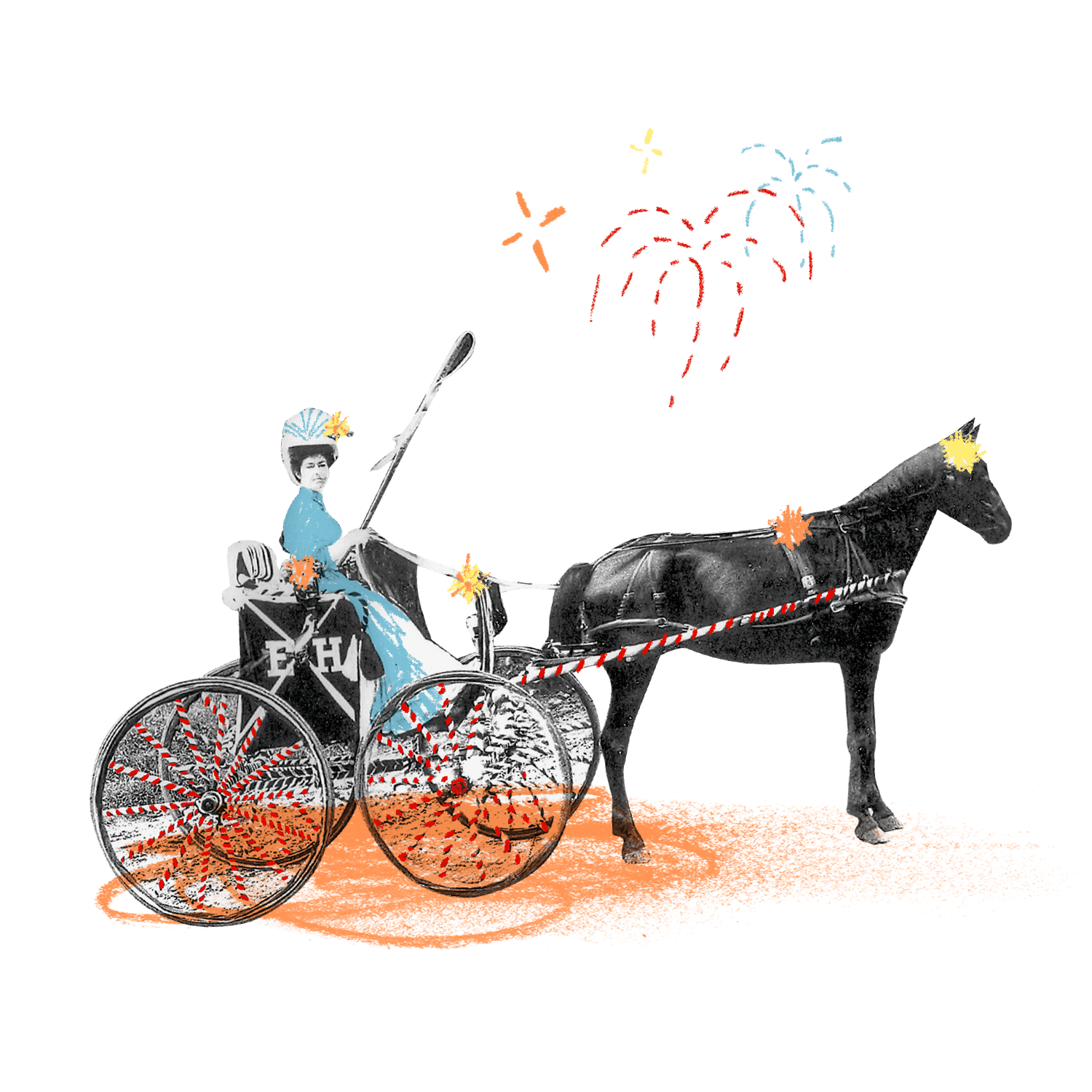
I became involved in the Griffitts family investigation during the fall of 2011, when University of Alabama history professor Dr. Joshua Rothman, aware of my ongoing research into the history of women institutionalized at Bryce Hospital, forwarded an email from Elizabeth’s granddaughter, Susan Dickson, on October 24, 2011: “My sister and I are pursuing the story of our grandmother, who was forcibly taken from her home and 5 children, to Bryce Hospital where she spent the remaining 30 years of her life, never visited by her husband or children, never claimed,” explains Susan in the email. “There is much room for questioning whether she was actually ‘insane’ or whether that course of action was merely a solution to the problem she presented her husband.” Nearly a century after Elizabeth’s institutionalization, shock waves continue to reverberate through generations of this family, as her granddaughters—one of them, Susan, now a grandmother herself—struggle to find meaning in the truncated life of their ancestor, the woman exiled from the family history. “We are so determined to know the story,” Susan writes, “to understand, and maybe rectify her after all these years.”
There is much room for questioning whether she was actually ‘insane’ or whether that course of action was merely a solution to the problem she presented her husband.
One weekend in December 2011, I visited three Griffitts sisters—Susan Dickson, Shelley Griffitts, and Sherry Wachs—women whose palpable bond and chorus of memories would thereafter enshrine them in my mind as “the Sisters,” an inseparable bunch. We decided to meet so that I could enrich my scholarship by reviewing their grandmother’s medical file; in exchange, I would provide my previous research on women institutionalized at Bryce Hospital to help contextualize their grandmother’s incarceration. Shortly after I arrived at Susan’s home near Charleston, South Carolina, Shelley read to me, from an unpublished deathbed memoir written by their father in 1994 at the age of eighty-one, the first account of their grandmother that I would hear. After generations of silence, we would spend what Shelley later termed a “fast and furious twenty hours” talking non-stop about a woman whose name long had been forbidden, a story that began, for me, with a death-facing confessional by an aged son about the mother he was taught to deny. The Sisters’ father, physician James (“Jack”) Griffitts, was twelve years old the day he watched his own father, Dr. Thomas Houston Dow Griffitts, along with two police officers, force his mother from their latest home in Montgomery, Alabama. In his memoir, tellingly titled Before I Go, Jack writes:
As I think of all the things I want to touch upon in this journal—I feel a need to make sure I have made a niche—a shrine for my sad beloved Mother. [T]o save my soul, I can’t get my Mother clearly in my mind. She is like a wisp of warm aura as I try to recall her closely. She loved me . . . I remember Mama best for her beautiful skin and black, black hair worn bouffant above her forehead. And her sweet smell . . . Sweet Mama . . . and Dad, wonderful to us—but maybe the number one problem for Mama, could not or would not save her. I never found a way to fault Dad for this. I accepted the mystery of psychosis as one of life’s natural hazards and I’m ashamed to say now that I wrote my Mother off—out of my life’s consciousness. Help me, God.3
Indeed Jack Griffitts did erase his mother from his “life’s consciousness.” Jack had been married to the Sisters’ mother for forty years before he admitted that his own mother had not in fact died when he was a child—as he had led his family to believe—but instead had been transferred permanently out of his young life and into Bryce Hospital.
Elizabeth had not always been so forgotten.
Elizabeth Glynn was born in 1880 in the then-booming port town of Cairo, Illinois, to a wealthy and respected Catholic family of Irish birth. In their rise from ethnic immigrants to bourgeois businessmen, the Glynns emblematized the mythology of the American Dream. As a young woman, Shelley told me, Elizabeth drove a one-horse carriage, decorated in ribbons and flowers, through the town’s parades. Likely, the photo that initially captured Shelley’s imagination depicts one such day. Elizabeth, dressed in lace and surrounded by blossoms, was a woman who mattered in Cairo, Illinois.
She was twenty-eight years old in 1908 when Thomas Houston Dow Griffitts, a brilliant young doctor from the Tennessee mountains, took a government job with the Marine Hospital Service in Cairo. Here—in the words of the pair’s son Jack, “thinking I don’t know what”4—Thomas married Elizabeth Glynn, despite the fact that, being both Irish and Catholic, Elizabeth embodied some of the deepest prejudices held by the Griffitts clan down South.
As Mrs. T. H. D. Griffitts, Elizabeth would never again enjoy the financial luxury of her youth. Nonetheless, Dr. Griffitts was a man of growing professional prestige. Throughout the decades that would follow, Dr. Griffitts built a reputation as one of the top players in the eradication of malaria in the American South. A man whom his son remembered as the “great Malaria fighter,” Dr. Griffitts’s southbound pursuit of the disease kept him away from home, “off in Louisiana, North Carolina, Georgia, Mississippi, Alabama—anywhere there [was] a program to eradicate malaria.”5
Certain burdens proved intrinsic to Elizabeth’s marriage to her ambitious husband. But despite frequent moves to impoverished communities, long stretches as sole caregiver, and a missing sense of membership in ever-changing local communities, “Mama seemed always there to comfort,” Jack recounts.6 Until one summer in 1924, another move deeper into the South, another year deeper into Dr. Griffitts’s domestic absence, another lifetime from ribboned one-horse carriages and long lace dresses, Elizabeth was removed—for reasons that remain, at best, enigmatic and suggestive—from her family, permanently.
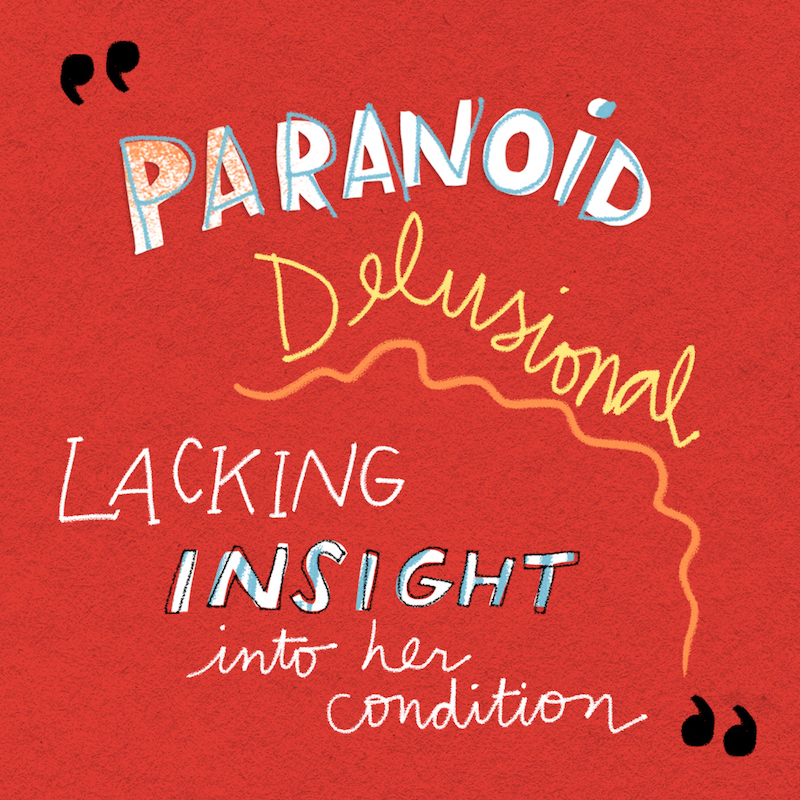
The couple had been married for fifteen years when Dr. Griffitts committed Elizabeth to Bryce on July 12, 1924.7 Elizabeth was forty-four years old, the five children ranging in age from fourteen to three. The Doctor, ever on malaria’s trail, had recently moved the family yet again—this time, from a home in Virginia (a place which Elizabeth would characterize in her admissions interview as her “real home,” a house she had “money in,” one she was “very interested in”) to Montgomery, Alabama, where she was miserable. “Less than a year in Montgomery and Mom was a bedraggled witch,” Jack writes:
Sometimes she would not or could not get out of bed. She would cry and scream and sometimes arm-slash Doll and me. And often for purposes we could not understand. And finally, one day Dad came with two policemen and they took Mama off to Tuscaloosa, Alabama, and in all those years since, none of us has so much as had one glimpse, or heard a whisper, nor smelled a bit of that lovely soul—my Mom.8
One summer day in 1924, three men took Elizabeth Glynn Griffitts from her home in Montgomery, from her children, from her life, forever. Other than the above account in her son Jack’s memoir, only vague diagnoses found across thirty years of case histories offer clues to the justifications that enabled those in power to determine that she was best kept in permanent custody, cut off from her children, her voice disabled and nearly erased from history. “Paranoid,” “delusional,” “lacking insight into her condition” prove the most frequent diagnoses littering these case histories and letters. As the vast correspondence between Dr. Griffitts and Bryce’s physicians stored in Elizabeth’s medical file attest, the children’s father ensured that mother-child communication was thereafter banned. “Fraternally yours,” Dr. Griffitts sometimes signed these letters. Tellingly, nearly all of Elizabeth’s own writings were either destroyed on site or intercepted by her husband and, though evidence of their existence populates the correspondence between doctors, outside of an admission interview and one early letter, her words—her voice, her perspective, her depictions of events—have not been preserved. In finding Elizabeth’s story, perhaps we can—in some modest yet loving capacity—find insight into others not so unlike Elizabeth, women whose voices were, like Elizabeth’s, suppressed, destroyed, speaking only through the cracks in the discourse that named unconventional women “insane.”
In finding Elizabeth’s story, perhaps we can—in some modest yet loving capacity—find insight into others not so unlike Elizabeth.
Discovering Elizabeth’s story has been, for the Sisters, a long process of dead-ends, misinformation, and perseverance. The Sisters’ closest source of potential insight into their grandmother’s life, their father Jack, would reveal little. “There was never an open door to the subject of Elizabeth,” Shelley explains. “My father would not speak of her.” But, despite years of deferral, when the Sisters’ mother died in 1985, Shelley’s mind turned again to her grandmother:
I remember saying to my father that I wanted to find out more about his mother. I also remember him saying that he didn’t want me to do so . . . All I had to go on was the fact that my father’s family spent their early years in various southern locations: Georgia, Virginia, Florida and Alabama . . . I began sending letters to various southern psychiatric hospitals: Chattahoochee in Florida, Milledgeville in Georgia and Bryce in Alabama. I hit dead ends with each request. I suppose I considered the task too daunting, and suspended the search. But, I never forgot.9
In 2000, Shelley once again pursued the mystery of Elizabeth, this time recruiting her sister Susan in the research. After sending a request to the state of Alabama for information about her grandmother, the Sisters received their first clue: a copy of Elizabeth’s death certificate. Elizabeth died on July 20, 1954, after 30 years and 8 days at Bryce Hospital. “From that day,” Shelley says, “I was determined to unravel her life’s story.” But when she filed a request for records at Bryce, a hospital employee claimed that no such records existed, reporting that they had been lost in a fire.
On a whim, eleven years later, in May 2011, Shelley once again made a phone call to Bryce Hospital. This time, after extensive questioning by a sympathetic hospital staff member, Shelley received the long-awaited good news: the file was in fact not destroyed in a fire, but instead had been located under the name of Mrs. T. H. D. Griffitts—and it was full of letters. The timing was fortuitous, the hospital employee noted, because patient information would no longer be released as of June 25, 2011, due to new federal patient privacy regulations. She had made the cut by mere weeks. Finally, after a long delay in delivery caused by the tornadoes that ravaged Tuscaloosa that summer, Shelley received a heavy box in October containing a copy of Elizabeth’s complete hospital file.
“The story would, I thought, draw to a close when the file reached my mailbox,” she remembers.
But rather than providing a clear-cut, easily digestible ending, the file presents instead a disturbing and cryptic portrait. The concrete nature of Elizabeth’s experience remains a mystery, as the doctors who dominate the conversations (including her husband) converse largely in detached clinical terms, devoid of individualizing details. The picture that does emerge of Elizabeth’s incarceration, however veiled, looks something like this: Elizabeth Griffitts was accused of insanity by her husband, an accusation she fervently denied. Yet, due at least in part to Dr. Griffitts’s authority as both patriarch and physician, the staff at Bryce concurred with Griffitts’s assessment of his wife, and further diagnosed Elizabeth’s denial of this insanity as a manifestation of mental illness. This diagnostic double bind—Elizabeth must either admit to insanity or her denial itself evinces insanity—provided Dr. Griffitts with the power to sequester his inconvenient wife, not only from the immediate world outside, but also from the consciousness of descendants yet born.
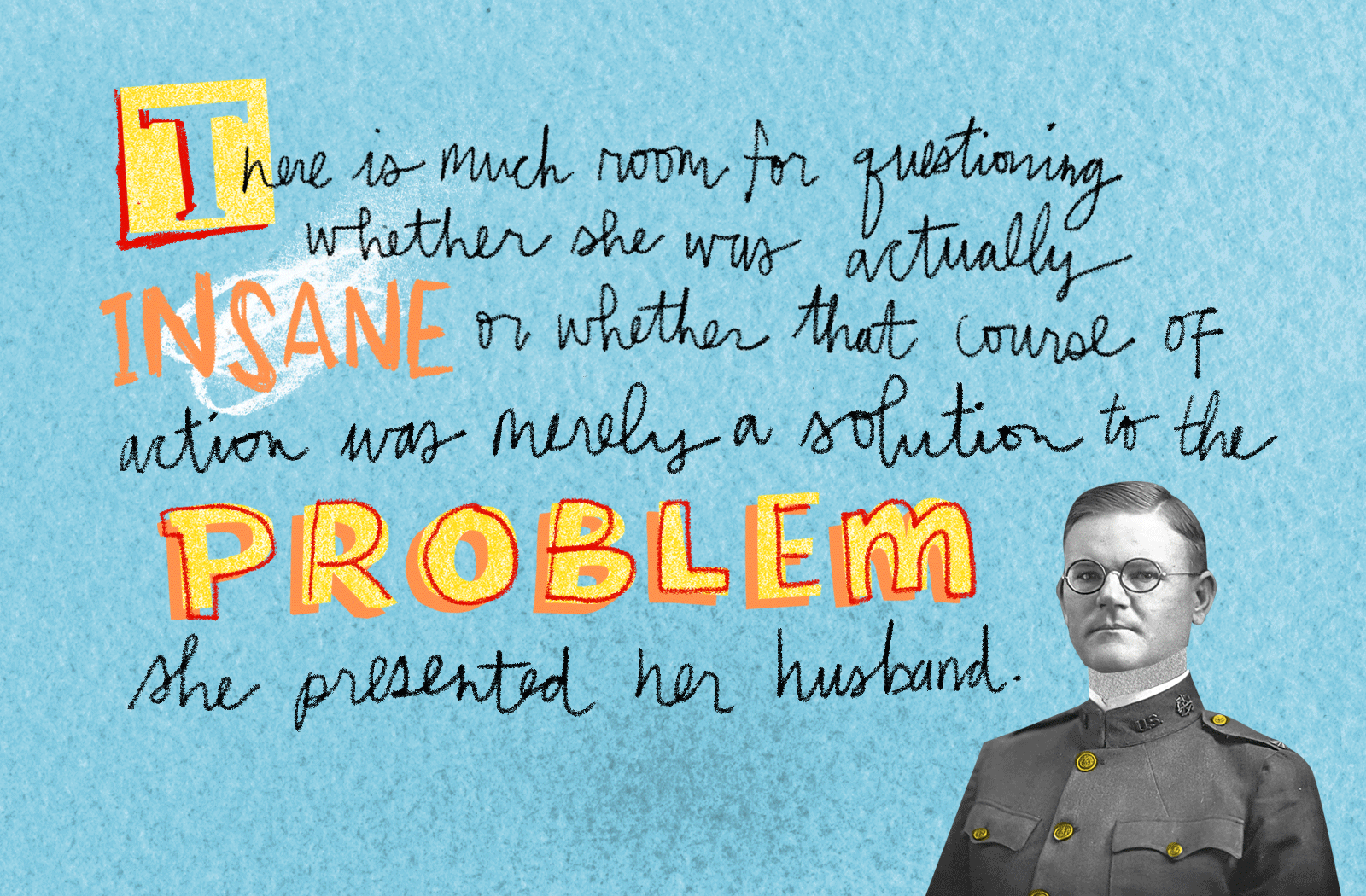
Among the many illuminating contents of Elizabeth’s file, the Admission Form filled out by Dr. Griffitts on July 12, 1924, and the “Patient Summary” interview of Elizabeth conducted by Bryce doctors thirteen days later on July 25, provide a particularly distilled portrait of the consultation, diagnosis, and correspondence that, in complex concert, outlined Elizabeth’s fate.
On the Patient Admission Form, Dr. Griffitts set in motion the diagnostic classifications that would circumscribe the path of his wife’s remaining years. On this form—in fact, throughout “Mrs. T. D. H. Griffitts”’s entire file—the exact events that triggered the doctor’s admission of Elizabeth into a mental institution remain unnarrated. The closest thing to a description of precipitating events—Dr. Griffitts’s account of Elizabeth’s “Present Attack”—catalogues “fits of temper—depression—jealousy—irrational acts and delusions, particularly on religion,” with “jealousy of attention shown to husband” as chief among his wife’s “mental deficiencies” (when the form later inquires explicitly, “Is she inclined to be jealous of her husband?” Dr. Griffitts answers simply, “Yes”). Furthermore, according to Dr. Griffitts, a “talkative” Elizabeth entertains “flights of ideas” revealing of a “suspicious” and “superstitious” mind. The duration of her insanity, Dr. Griffitts notes on this form, has lasted fifteen years—the same duration, remarkably, of the couple’s matrimony at that time. His wife had become, according to the Doctor, “very difficult” to manage. Perhaps the core of Elizabeth’s difficult personality may be expressed in the following questions and answers on the Admission Form:
“Was she ever called peculiar?” the form asks. “Yes,” Dr. Griffitts replies.
“Eccentric?”
“Yes.”
“Weak-minded?”
“No.”
Thirteen days after her admittance, in the interview of Elizabeth conducted on July 25th by staff, Elizabeth displays for Bryce’s doctors such “peculiar” “flights of ideas.” As she refuses to follow the doctors’ leading questions in the directions intended, even going so far as to suggest that her husband undergo interview as well, Elizabeth convinces Superintendent Partlow and his colleagues that she deserves admission into Bryce Hospital as a likely incurable case.
The admissions interview, the transcript spanning only one and a half pages, seems to have taken perhaps fifteen minutes. Over the course of this interview, Superintendent Partlow spends much of this time quizzing Elizabeth about her relationship to her husband. Through seemingly rhetorical questions as “He has always treated you squarely, and you have not had to keep a watch on him?,” Partlow repeatedly characterizes Dr. Griffitts as a man who has treated Elizabeth fairly—a characterization that Elizabeth refuses to endorse.
“You and the Doctor have always gotten along very smoothly and pleasantly, have you?” Partlow asks.
“You should have him here to help answer that question—I think there are always two sides to everything,” Elizabeth responds.
The interview provides a glimpse not only into Elizabeth’s unhappy marriage, but furthermore into her dissatisfaction with her various southern homes—places which, clearly, did not compare to her finer northern origins. Regarding her recent residence in Montgomery, Elizabeth says, “I think that was kinder [sic] just camping because it was not my home.” Of her previous residence in Dothan, Alabama, Elizabeth exclaims, “It was very disgusting to me!—never very satisfactory.” Adding to her discontent, Elizabeth found her neighbors in Alabama to be supremely un-neighborly: she accuses them of spreading “absolutely malicious lies” about her, affronts to which she responded by acting “a lady the whole way through.” As a devout Catholic from a prosperous northern town, implanted without enthusiasm into the depths of the (Baptist) Bible Belt, Elizabeth was a pariah, a woman without friends, uncomfortable and seemingly unwelcome in her ever-changing southern environments. This alienation—paired with the apparently deceptive means used by Dr. Griffitts to bring his wife to Bryce (“I thought I was going to a Rest Hospital somewhere!” Elizabeth recounts in the interview)—seems impetus enough to trigger her transformation into the “bedraggled witch” of her son’s memory, the “manic” patient of doctors’ description. Yet those conducting her evaluation do not entertain this possibility. Rather, they seem more concerned with situating Elizabeth as a child-like madwoman incapable of recognizing her insanity.
They seem more concerned with situating Elizabeth as a child-like madwoman incapable of recognizing her insanity.
“I wonder if Mrs. Griffitts knows or realizes how upset and how confused she was when she came in?” Dr. Lawrence, a colleague of Partlow and fellow interviewer, muses.
“Maybe Dr. Griffitts will tell you—if you can see him!” Elizabeth responds. “I never wanted to come here. I begged the Doctor not to bring me here . . . The whole thing rests with Dr. Griffitts . . . I think we both should be questioned.”
At this, “the patient” is dismissed.
During the evaluation that follows, Bryce physicians concur with Dr. Griffitts’s assessment of his wife.10 Dr. Partlow, along with Lawrence and Dr. Kay, diagnose “the patient” as exhibiting “Paranoid Defence of herself” accompanied by occasional “Manic Attacks.”
“She was as wild as anybody I have ever seen,” Kay notes of Elizabeth’s “manic” behavior upon her forced arrival at Bryce.
“I saw her when she had her face half covered up, and would not speak to anybody,” Partlow adds. “She doesn’t seem to have any appreciation of that at all.” Although Partlow briefly questions his own diagnosis—“she could have just been furiously mad with her husband about something”—finally, he concludes that her use of “‘I’ and ‘My’ so much is Paranoia.”
With these words, Partlow and his cohorts deem Elizabeth insane.
Case history characterization of Elizabeth remains largely unchanged throughout her thirty-year tenure at Bryce.11 Her first case history report from July 21, 1924, exemplifies the relatively consistent official institutional description of Elizabeth: “She is now quiet and orderly, but has the attitude of a paranoid individual,” this first report reads. “She has no insight into her condition, does not believe that her mind has been upset. She seems very much interested in her children, but seems to dislike her husband.” (An almost-supplementary “She has spoken frequently of a National Woman’s Party, and seems to be quite interested in politics” suggests as much about contemporary notions of women’s madness as Elizabeth’s state of mind.) A few months later, in an October 27, 1924 letter from Partlow to Elizabeth’s sister-in-law, Mrs. J. P. Glynn, one of her persistently inquiring relatives from Cairo, Partlow adds to the description of Elizabeth’s “condition” another theme that populates official accounts of her insanity: Elizabeth possesses “a mental condition which makes her think she is not treated fairly.”
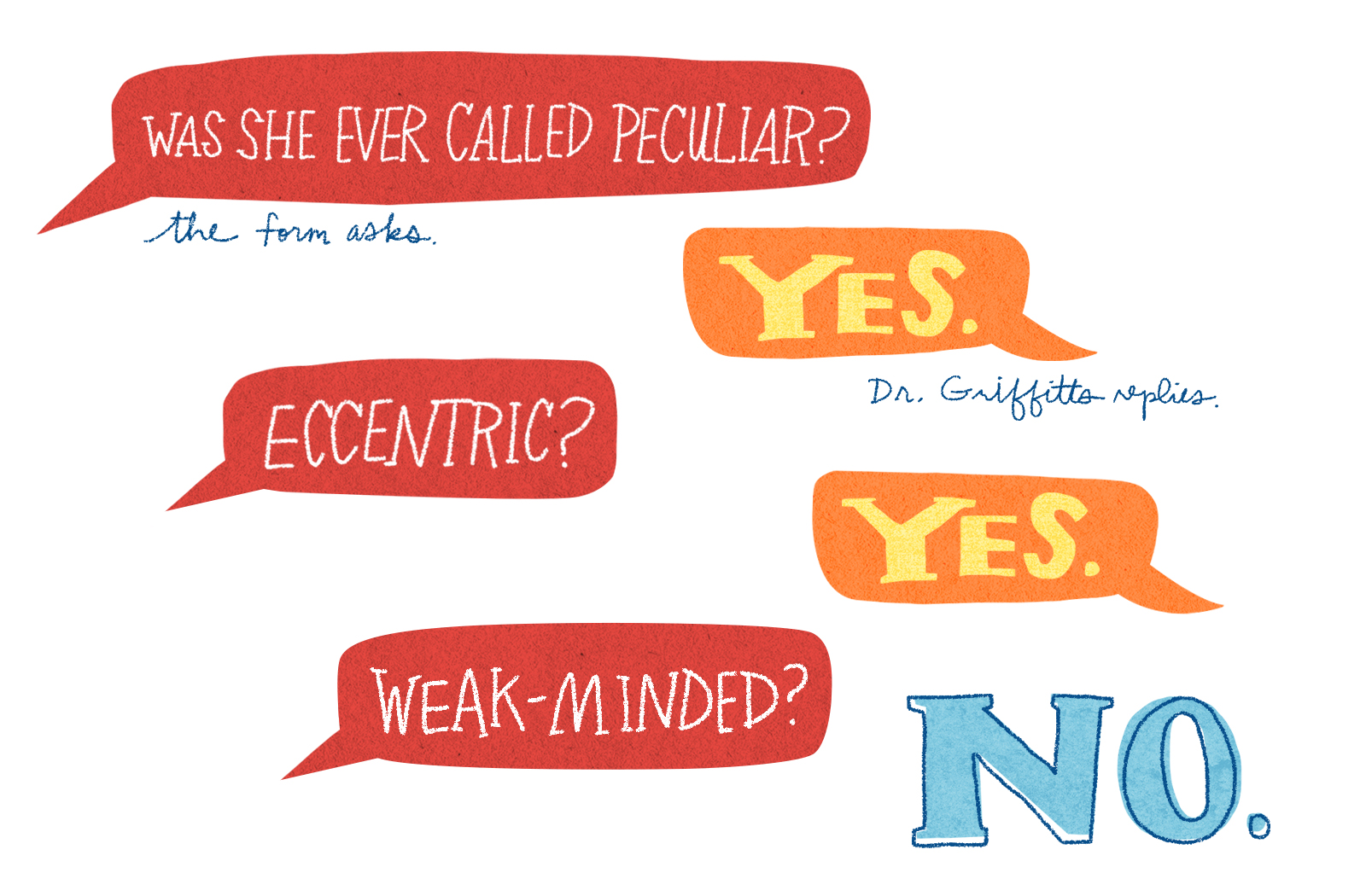
These diagnoses not only eliminate any space for Elizabeth’s credible profession of sanity, but in turn endow her husband and legal guardian with the authority to make vastly consequential judgments about the course of her remaining life. Perhaps most consequential of these choices proves Dr. Griffitts insistence, as stated in one of his many similarly themed letters to Partlow, that the institution address “all letters to any members of her family, directly to me.”12
Dr. Griffitts issues this order several times in 1928. Two letters from this period, written by Partlow and addressed to Miss Mary Griffitts (Elizabeth’s oldest child, sixteen at the time, better known within the family as “Doll”) shed light on the source of Dr. Griffitts’s increased anxiety. In a May 28, 1928 letter from Partlow to Mary (sent, notably, to a P.O. Box bearing a different address than Dr. Griffitts’s own) and addressed to “My dear Miss,” Partlow customarily pens a note of receipt for a pair of slippers sent from Mary to her mother at Bryce. The slippers are too small, Partlow explains, and he requests that Mary send an exchange pair.
Just a little over a week after this exchange between Partlow and “Doll,” on June 8, 1928, Dr. Griffitts sends the following message to Partlow:
I appreciate you sending any letters to me first . . . Of course any letters that are sent by her I want forwarded to me, but I know there are many meaningless notes which you may determine yourself are of no value and may better destroy them than to bother with sending to me. The main thing that I wish to avoid is having the children’s peace of mind disturbed by letters reflecting her condition of insanity. Occasionally these letters reach them . . . It took the children some weeks to recover from the excitement caused by her condition before she was separated from them, and I find it best that they are advised of her condition only through me.
Dr. Partlow’s request for a replacement pair likely never reached its intended recipient, nor did any letter from Elizabeth thanking her daughter. Regardless, any exchange of slippers quickly became impossible, as suggested by a second letter from Partlow to Mary, sent on June 7, before Dr. Griffitts’s letter of admonishment had even been written, much less received. In this letter, Partlow recants the request for a replacement pair. “I find that she has been wearing them for the past few days,” Partlow explains, and has worn them out too much for an exchange. One can only imagine Elizabeth, two years deep into excommunication from her children, receiving this (likely clandestine) gift of slippers from her teenage daughter and promptly wearing them out, these too-small tokens of remembrance from her oldest child. Although her case history notes that she often inquires after her family, this image of ill-fitting but worn-out slippers perhaps most poignantly depicts Elizabeth’s longing for a connection to her children. These two letters, however, constitute the only evidence of Elizabeth ever hearing from any of them.
And what of the Glynns, Elizabeth’s family in Cairo, the people alongside whom she had enjoyed such hometown prestige? How did this prominent family allow one of their own to disappear within the walls of a run-down and over-populated southern mental institution? In fact, several members of the Glynn family, including Elizabeth’s sister-in-law, brother, and nieces, not only wrote and visited Elizabeth at Bryce during the early years of her confinement; they furthermore made attempts to have Elizabeth released into their care.13 On October 26, 1924, roughly three months into Elizabeth’s incarceration, her sister-in-law writes Dr. Partlow to ask, “Do you think that if she was with her relatives her condition would improve? . . . If your reply is favorable, I will write Dr. Griffitts for permission to come after her.” With both institutional recommendation and Dr. Griffitts’s permission apparently denied, on January 26, 1925, Mrs. Glynn writes again to inform Partlow that a relative named “Mr. Kierce” plans to travel down South in order to “force hospital to release her.” No record of such an attempt exists. Dr. Griffitts, wary of the potential of mother-child contact should his wife obtain freedom, finally requests that the hospital simply discontinue correspondence with Elizabeth’s kin. “As to her brother, John P. Glynn, Cairo, Illinois,” Dr. Griffitts explains in a February 10, 1929 letter to Dr. Partlow, “he is not a physician and will not appreciate the relative importance of conditions and it will be best not to disturb him with copies of letters to me or advise him, except through me.”
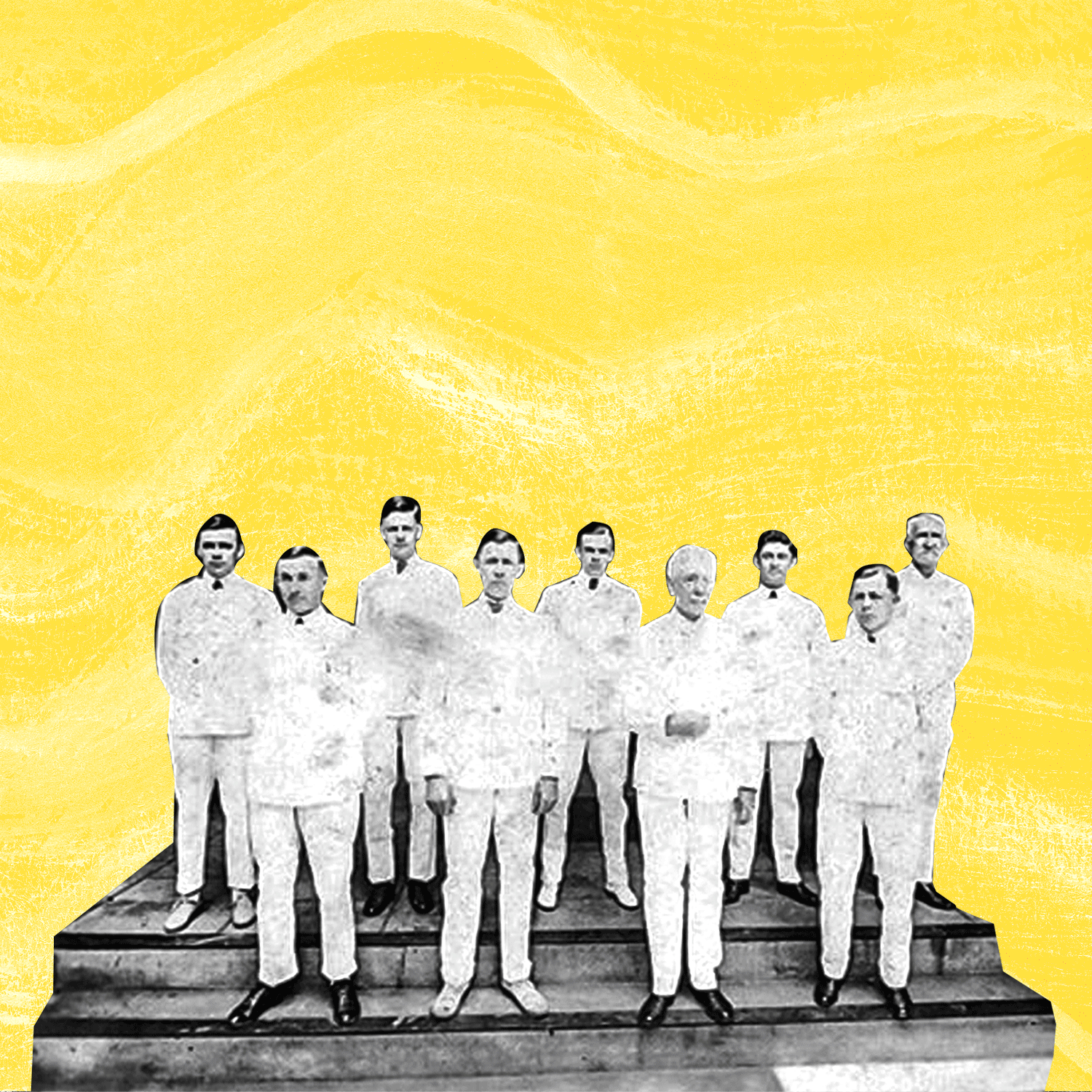
A steadily tapering correspondence of letters and gifts ends with three consecutive visits from a Glynn family niece in March 1932.14 Following this, only one letter of inquiry from another niece, Mrs. Wheeler, written sometime in 1943, and another letter, also from Mrs. Wheeler, dated July 21, 1954, and written in acknowledgment of Elizabeth’s death that day, provide evidence of continuing correspondence with the Glynns. While Susan and Shelley have attempted to find Glynn family descendents, even once in the 1990s visiting Cairo in their search, they have yet to find a relative who remembers their grandmother.
In fact, the majority of all correspondence kept on Elizabeth’s file dwindles sharply after the first decade of her institutionalization. It must be remembered, however, that Elizabeth remained thirty years and eight days in that institution, starting in the forty-fourth year of her life, ending only with her death. When Elizabeth entered Bryce, she was a mother of toddlers and teenagers, a woman with a busy life, a sharp tongue, and a proud history; when she died there at the age of seventy-four, she was quiet, lonely, and blind, without a single possession to her name or relative by her side.15 What happened during those long years in between?
Only one Visitor’s Slip from Dr. Griffitts exists on file, dated December 24, 1924. Less than two years into her incarceration, on February 2, 1926, Dr. Griffitts filed a petition with the State of Alabama Probate Court for an “Inquisition of Lunacy” against his wife; Elizabeth’s file, however, contains no results from this Inquisition. According to a September 28, 1929 letter from Dr. Griffitts in which he urges Partlow to provide verification of his wife’s “mental condition” to the Chancery Court—a charge, he emphatically underlines, to be “of the utmost importance”—it seems Elizabeth’s “mental condition” provided the grounds for his divorce from her in 1929. He remarried that year. Judging from case history reports from the 1930s documenting Elizabeth’s disgruntlement with her husband, Elizabeth apparently remained unaware of the Doctor’s marital maneuvers for quite some time.16 After a six-year lapse in a dramatically dwindling correspondence, Dr. Griffitts transferred Elizabeth to the state’s custody in 1940, making her, from that year forward, a member of the “indigent class” of patients.17 On January 6, 1947, over a decade after quitting all concern for his then ex-wife, Dr. Griffitts finally relinquished legal guardianship of Elizabeth’s estate. A case history entry written on July 4 of that same year notes of Elizabeth: “Says often she wants to go home.”
Although the reports, letters, and diagnoses offer compelling—and haunting—insight into the nature of Elizabeth’s experience at Bryce, perhaps the fate of her physical body offers the most distilled narrative of her life after commitment. The first two case history reports, written on July 21 and August 9, 1924, note, respectively, that “it became necessary to tube feed her,” and that “she has not eaten for several days.” Three years later, on May 31, 1927, another case history reports that an otherwise “fairly well nourished” Elizabeth has lost a substantial 40 pounds in the last year. “She is somewhat paler and thinner,” Dr. Partlow writes to Dr. Griffitts in 1928. According to case history reports that list weight losses and gains in the dozens of pounds over the course of her institutionalization, years of dramatic weight fluctuation mark the remainder of her life—along with other major medical problems. The same May 31, 1927 report noting the 40-pound weight loss also indicates the presence of infection in her eye; by February 1929, the infection had so destroyed the eye as to require its removal.18 Elizabeth “needs dental work badly,” this 1927 report continues; by 1942, only five teeth remain.19 By the time of her death in 1954, case history reports describe Elizabeth as “totally blind and needs constant supervision in all of her activities,” a “feeble” woman who “sits around the ward most of the time and will not go to any of the entertainments.”20
When she dies of an apparent “coronary thrombosis”21 on July 21, 1954, her son Jack sends a telegraph to Bryce requesting her effects. The hospital replies two days later, “We are sorry to advise you that Mr. [sic] Elizabeth Griffitts did not have any belongings already for several years. Her last dresses were sent to her in 1951 and she has worn them out since then.”
We are sorry to advise you that Mr. [sic] Elizabeth Griffitts did not have any belongings already for several years. Her last dresses were sent to her in 1951 and she has worn them out since then.
Elizabeth hadn’t always been so forgotten.
In the only letter of hers preserved on file, written to a Miss Humphry (relationship unknown) just four months after her incarceration on November 1, 1924, Elizabeth, unaware of the fate that lies before her, still believing that her words could control her life, unleashes one of her much-maligned “fits of temper” in passing a request along to her husband for a little bit of money: “I’ll soon be here four months and I have not be[en] able to purchase a spool of thread, I am starved for something to eat, and I’m barefooted for footwear,” she writes. Then, in the spirit that seems to have gotten her into so much trouble, she declares, “indeed I don’t have to tolerate any such embarrassment, even at the Bryce Hospital.”
How long Elizabeth maintained this resolve remains unanswered, evidence of her spirit destroyed along with her letters. Determined too dangerous to exist, Elizabeth’s voice barely survives the historical chorus of professional opinions written about her. Long years of earnest research have left the Sisters with only this single letter from Elizabeth’s own hand, rendered barely readable by eighty-seven years and multiple trips through copy machines. Although the final lines prove illegible and her last preserved sentence impossible to fully translate, of these hand-written words, I can make out only two, emphatically underlined: “my children.”
This essay first appeared in vol. 20, no. 2 (Summer 2014).
Lindsay Byron is a lecturer in the School of Literature, Communication, and Media at Georgia Institute of Technology, where she devotes most of her scholarship to women’s modernist writing, the American South, and multimodal composition. Her current book/multimodal project, “The Straightest Story Ever Told in Alabama”: Three Eccentric Women Tell of One Southern Mental Institution, 1890–1965, draws on medical files, diaries, and family remembrances to tell the stories of three women unwillingly institutionalized at Alabama’s notorious Bryce Mental Hospital.NOTES
- Email to the author from Shelley Griffitts, December 13, 2011.
- See James Cowles Prichard, “A Treatise on Insanity and Other Disorders Affecting the Mind,” Mental Illness and Social Policy: The American Experience, ed. Gerald N. Grob (New York: Anro Press, 1973) for Prichard’s foundational definition of “moral insanity;” see also Lucy Ozarin, M.D, M.P.H., “Moral Insanity: A Brief History,” Psychiatric News 36, no. 10 (May 18, 2001): 21; as well as Benjamin Reiss, Theaters of Madness: Insane Asylums and Nineteenth Century Culture (Chicago, IL: University of Chicago Press, 2008) for the history of “moral treatment.” See John S. Hughes’ introduction to his edited collection The Letters of a Victorian Madwoman (Columbia: University of South Carolina Press, 1993); Carla Yanni, The Architecture of Madness: Insane Asylums in the United States (Minneapolis: University of Minnesota Press, 2007); Gerald N. Grob, Mental Illness and American Society, 1875–1940 (Princeton, NJ: Princeton University Press, 1983); as well as the Bryce Hospital Collection, MSS.0225, housed at the University of Alabama’s W. S. Hoole Special Collections Library in Tuscaloosa, for more information about Bryce’s history. The 1907 Legislative Investigation of the Alabama Insane Hospitals, as well as the 1957 APA investigation report, can also be found in W. S. Hoole’s Bryce Hospital Collection. More information about Wyatt v. Stickney can be found in the Alabama Disabilities Advocacy Program Newsletter, July 2004, 1–3.
- Dr. James Johns Griffitts, Before I Go, unpublished memoir, ca. 1994, 5–9.
- Ibid., 4.
- Ibid., 6.
- Ibid.
- Date listed on institutional Admission Form in Elizabeth’s medical file, property of Susan Dickson.
- James Griffitts, Before I Go, 8.
- This and the following information about the Griffitts sisters’ search for documentation about their grandmother comes from a December 13, 2011 email from Shelley Griffitts, sent to the author.
- The evaluation is included on the “Patient Summary” document containing her interview.
- This case history, included in Elizabeth’s hospital file, spans from her admission in 1924 to her death in 1954, and contains reports made with variable regularity (sometimes staff makes multiple reports over the course of one month, while other times only one report a year appears on file).
- From a March 10, 1928 letter from Dr. Griffitts to Dr. Partlow.
- The Visitor Forms included in Elizabeth’s medical file document occasional visits from Glynn family members.
- See Bryce Visitor Forms from March 16, 17, and 18 for documentation of Marie Glynn’s visits to her aunt.
- See Case History reports, particularly from the 1940s and ’50s, for evidence of Elizabeth’s declining health.
- See, particularly, the case history report from July 3, 1931, which notes, “She feels a little ill toward her husband because he does not come to see her.”
- A November 25, 1940 report from the Alabama Probate Court, included in Elizabeth’s file, notes this transfer from paying patient to “indigent.”
- See Partlow’s February 8, 1929 letter to Dr. Griffitts requesting permission to remove the eye, as well as Griffitts’ February 10 response granting permission, for record of this operation.
- As noted in the August 24, 1942 case history report.
- This final comprehensive overview of Elizabeth’s physical state appears in a May 23, 1951 Case History report.
- This is the cause of death listed in the hospital’s July 21, 1954 letter to Dr. Griffitts informing him of Elizabeth’s passing.


